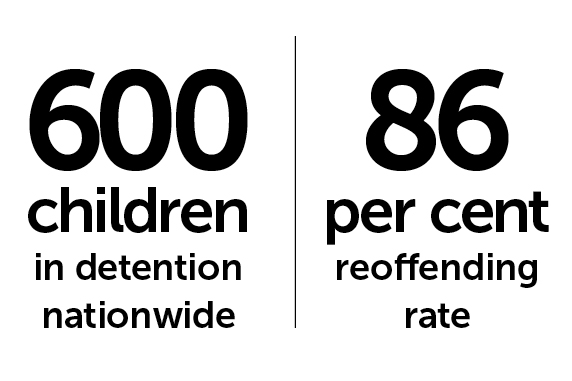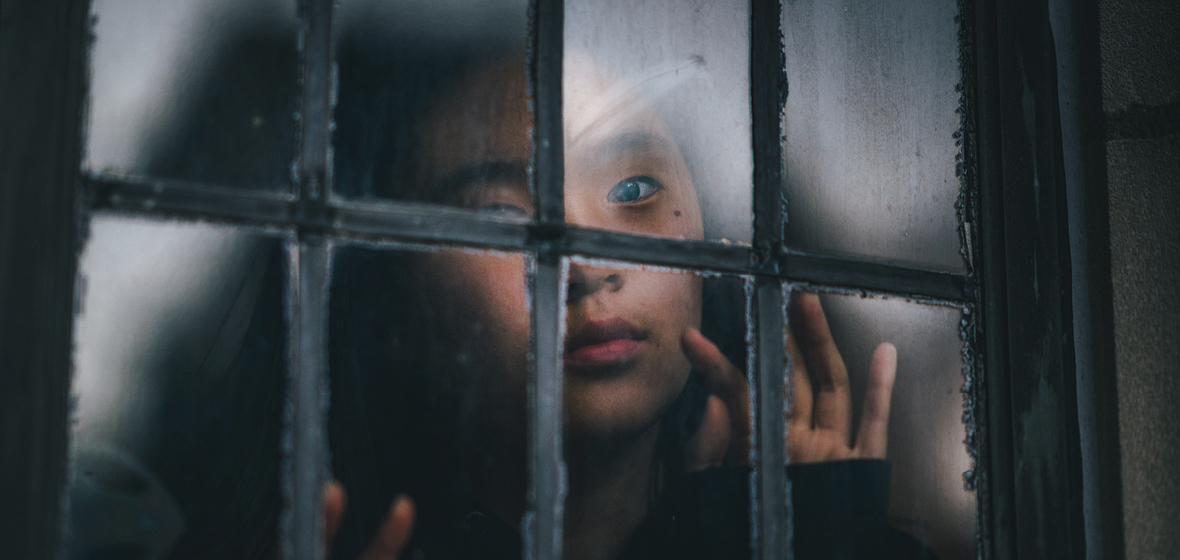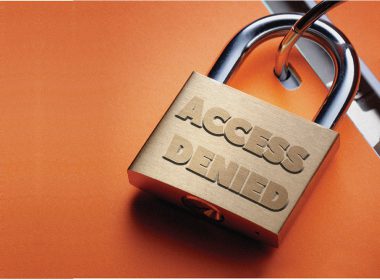We know that children who are placed in detention have at least an 80 per cent chance of reoffending. It is an extraordinarily high rate.
Every year, hundreds of children younger than 13 sit inside Australian juvenile detention centres. They aren’t old enough to drive a car. Yet the justice system has set them on a criminal pathway that sends the vast majority into adult prisons. We explore the case for raising the minimum age of criminal responsibility.
On Adam’s* tenth birthday, police knocked at his front door. On a day when most kids have a party or eagerly unwrap a present, Adam was instead asked 27 questions by police.
His answers would set the course for the remainder of his childhood. Research attests they will also set the scene for the rest of his life.
By the time he was 14, Adam had faced more than a dozen court hearings as prosecutors sought to rebut doli incapax – the presumption that children under 14 cannot be held responsible for criminal offending because they are not aware such behaviour is seriously wrong. Prosecutors tried to rely on the answers he had given on his tenth birthday – about what constitutes right from wrong – in those cases.
Adam spent time in custody and was subjected to a partial clothing search – where one half of the clothing is removed at a time to strip search the other half. He breached bail more than 20 times, including for failing to report to police, with seemingly no thought given to the difficulty a child who cannot drive and has no money for public transport might face in getting to the station.
He is now 17 years old and back in custody. Tragically, his case is not unique. In a nation of plenty, for too many Australian children there is nowhere to graduate but into a life of crime.
Each year, 600 children between the ages of 10 and 13 languish in detention nationwide, having been charged with or found guilty of criminal behaviour ranging from theft to serious acts of violence.
Now many lawyers, doctors and child protection advocates say it is time to end this. Many leading organisations, including the Law Council of Australia, the Aboriginal Legal Service, Legal Aid, the Australian Medical Association, the Australian Human Rights Commission and the Law Society of NSW are calling for the minimum age of criminal responsibility to be raised to 14 years old and the removal of doli incapax.
“In supporting raising the minimum age of criminal responsibility, the Law Society considered a number of factors including the limitations of doli incapax, the disproportionate impact of the present age of criminal responsibility on Indigenous children, development and cognitive considerations, recommendations from relevant stakeholders, and alternatives to a criminal response for children,” says 2020 President of the Law Society of NSW, Richard Harvey.
Data from the Australian Institute of Health and Welfare has found children within the child protection system are nine times more likely than other young people to commit crimes and end up in juvenile justice facilities.
The Australian Institute of Criminology (AIC) released a report in December 2019 highlighting the over-representation of children known to the child protection system in juvenile justice – known as the “care to custody pipeline”. Of those cases examined by the AIC, there was a significant increase in the number of charges a young person faced if the very first charge against them was recorded before they turned 14.
 Pauline Wright
Pauline Wright
Breaking the cycle of Indigenous incarceration
In the Redfern office of the Aboriginal Legal Service, Children’s Criminal Practice State Manager Keisha Hopgood pores over files held together by bulldog clips. Each document represents another charge, another court appearance, another attempt by the justice system, she says, “to punish these kids into compliance”.
Her workload is relentless. According to the Australian Institute of Health and Welfare, Aboriginal and Torres Strait Islander children are more than 20 times more likely to be placed in detention than non-Indigenous youth.
Moments before speaking with LSJ, another case of an accused 10 year old comes across her desk. The boy in question was not even tall enough to be seen over the dock in his first court appearance.
Hopgood’s files include stories of children put behind bars for stealing a strawberry milk. Another for joining in with the adults in a protest in one of the state’s most disadvantaged communities. In one of the files, the child had been asked to complete a worksheet used by police to rebut doli incapax, and instructed to draw a circle around the phrases that represented very bad behaviour. “Kicking someone” was circled. So was “staying up past bedtime”.
“It is a travesty and a disgrace that we are further traumatising already traumatised kids, and subjecting them to further disadvantage, increased likelihood of recidivism, and poorer outcomes,” Hopgood tells LSJ.
“These kids, without exception in my experience, are from backgrounds of a combination of significant trauma, significant disadvantage, and often face racism at the hands of police.
“In my view, locking children up does not ultimately protect the community, and does not stop the behaviour. We are actually compounding the problem and ensuring it will continue. If we focus on punishment we set the stage against rehabilitation.”
In another file, a transcript of the police interview captures the moment officers ask a young boy, facing a minor charge, if killing someone is a bad thing. When he responds yes, they ask him who he would be in trouble with. He suggests an older boy in year seven, and then his mum.
Australia’s preparedness to detain children was under the microscope again last year when 12-year-old Arrernte/Garrwa resident Dujuan delivered a stirring address to the UN, telling delegates of his fears of being locked up at 10 and taken from his family.
“I was nearly locked up in jail,” Dujuan told the UN. “I was lucky because my family, they know I am smart. They love me. They found a way to keep me safe.”
Hopgood wants to highlight an important crossroad in one of her cases – Cameron*, charged at age 11 with damaging property.
Facing the prospect of full-time custody after breaching the conditions of a suspended sentence, Cameron started working with a support worker, who took him to school in the morning and played sport with him at lunchtime. His behaviour began to improve and he started attending school full-time. He won an adademic prize.
Yet Hopgood feared Cameron would be locked up when he went back before the court for sentence. But she says the Magistrate recognised the changes Cameron had made with appropriate support. He did not have to return to custody.

Violence in the very young
But what about children who have committed unspeakable crimes? Support for diverting young people who have dabbled in petty offending from the criminal justice system is relatively common. The question becomes more complex when the crimes are more violent, their harm irreversible.
An example is Bronson Blessington. At age 14 and as part of a gang, he raped and murdered young Sydney woman Janine Balding in 1988. Blessington has now spent more than two-thirds of his life behind bars and all appeal options have been exhausted. His case has been mentioned before the United Nations (UN) as an example of Australia’s laws on child offenders being among the harshest in the world. The UN found Blessington’s sentence was in breach of treaties Australia has ratified, including the Convention on the Rights of the Child, and amounted to “cruel, inhuman and degrading punishment”.
Experts believe such rare cases should not be the standard bearer for legislators.
“Bad cases make bad law,” President of the Law Council of Australia Pauline Wright tells LSJ.
“It cannot be stressed enough how rare these cases are. It is not a normal thing. Even though we are talking about a tiny percentage of cases, there should be that capacity for consequences for young offenders – but that is not holding them criminally responsible, because criminality implies an understanding of what they have done.”
Hopgood agrees.
“We do need to know what to do in those rare cases where someone between 10 and 14 commits a really serious offence such as a murder. It is a valid conversation, but it cannot dominate the conversation,” she tells LSJ.
Applying doli incapax
Some experts believe the application of the doli incapax should be banished entirely, and a higher minimum age of criminal responsibility of 14 years old be introduced in its place.
Wright says while the principle “might be sensible and clear on paper, it’s a really complicated test to use in practice”.
She says that in order to rebut the presumption, the prosecution will often lead “really prejudicial” material to establish the child’s intent to commit the crime.
Wright’s predecessor as Law Council President Arthur Moses SC said after a council of Attorneys-General [CAG] meeting where the issue of the age of criminal responsibility was debated, “the incarceration of children as young as 10 is a national tragedy”.
“There is something wrong when children can’t join Facebook until 13 but in Australia can be prosecuted for a criminal offence at 10. It does not make our country safe but exacerbates the problem,” Moses said in a statement following the CAG summit.
“Each day that goes by sees another child being charged or detained who should not have been dragged into the criminal justice system. I urge the Attorneys to not put this on the back burner but act with speed – the lives of children depend on their actions.”
 Tracy McLeod Howe
Tracy McLeod Howe
Our society should be an international exemplar and have the UN Convention on the Rights of the Child at the heart of all systemic responses that involve children and young people.
The case for change
As the new President, Wright tells LSJ the Law Council believes a preventative approach is best, and the distinction between making young offenders accountable for their behaviour and holding them criminally responsible must be drawn.
Data from the Productivity Commission indicates the recidivism rates for jailed adults hover around 50 per cent. For young people placed in detention, the reoffending rates can be as high as 86 per cent.
Wright points to countries like Denmark, Portugal and Sweden, which do not place anyone under the age of 18 in detention; a policy decision that has not resulted in soaring crime rates.
“In fact, it has been the opposite and the recidivism rates are much lower,” Wright says.
“In those countries there has not been a shoot-up in rates, there haven’t been negative consequences on crime rates. Meanwhile, we know that children who are placed in detention have at least an 80 per cent chance of reoffending. It is an extraordinarily high rate.
“Let’s do this now. The sooner we change this, the better it will be for the community.”
Tracy McLeod Howe, CEO of the Child Abuse Prevention Service (CAPS), says more work needs to be done to recognise the impact of adverse childhood experiences on young people and supporting them to ensure they do not begin a cycle of committing crime.
She says the detention of children as young as 10 “strips our most vulnerable of their dignity and safety”.
“Children in these circumstances have already experienced significant trauma and require specialist support and compassion, not punitive interventions,” McLeod Howe tells LSJ.
“Our society should be an international exemplar and have the UN Convention on the Rights of the Child at the heart of all systemic responses that involve children and young people.
“We need to listen to our most vulnerable and give them a voice.”
The Australian Medical Association, in supporting raising the age, notes the part of the brain that governs reasoning and impulsivity does not completely develop until adulthood. Internationally, research from Georgetown University suggests young people “get the accelerator long before they get the brake”; the part of the brain governing impulsivity and risk-taking behaviours peaks in adolescence.
“The test of doli incapax asks whether a young person knew their alleged behaviour was seriously wrong in a moral sense. However, it does not take into account what the research tells us; that young people are impulsive and easily led by peers. They don’t stop before they act and consult their moral compass, weighing up the pros and cons of their actions. They don’t think consequentially,” Hopgood tells LSJ.
However, the indication from politicians is not promising. Federal Attorney General Christian Porter says he is “not a particular enthusiast” about the reform in question and maintains the current system “works relatively well”.
Many believe the difficulty of proving charges beyond reasonable doubt misses the point of the damage done to children kept in detention.
“Rather than spending money on detaining, let’s spend the money on helping them through prevention and early intervention programs,” Wright tells LSJ.




